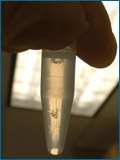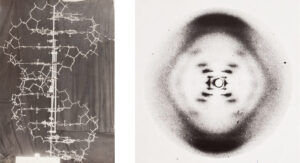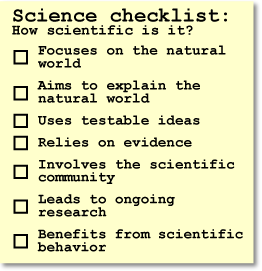James Watson, Francis Crick, Maurice Wilkins, and Rosalind Franklin all played a role in discovering the structure of DNA, deoxyribonucleic acid — the molecule that encodes genes in all living things. Compare their investigation to the science checklist, and see how you think it measures up.


![]() Focuses on the natural world?
Focuses on the natural world?
DNA is a molecule found in the cells of all living creatures.
![]() Aims to explain the natural world?
Aims to explain the natural world?
In the 1940s and 50s, genetics was a hot topic. People knew that offspring shared characteristics from both parents, but no one knew what the genetic material that carried that information was. A major clue came in 1944 when Oswald Avery and his colleagues1 performed an experiment that suggested DNA was the molecule behind inheritance. This discovery and others led Watson, Crick, Wilkins, and Franklin to study DNA. They thought that knowing DNA’s structure would help explain how genes work.
![]() Uses testable ideas?
Uses testable ideas?
Watson and Crick worked on the structure of DNA using wire models of atoms and molecules similar to those used in many chemistry classes today. The paper they published proposed a hypothesis for DNA’s structure which could be evaluated against data on DNA’s chemical constituents, X-ray diffraction images of DNA’s structure, and what was known at the time about how atoms fit together.
![]() Relies on evidence?
Relies on evidence?
Earlier researchers had gathered evidence suggesting that that the constituents of DNA always combine in simple, predictable proportions. Rosalind Franklin and Maurice Wilkins produced X-ray images of DNA that provided crucial clues to its structure. These lines of evidence, along with many others, inspired and supported Watson and Crick’s ideas about the location of the different types of atoms within a DNA molecule.

![]() Involves the scientific community?
Involves the scientific community?
Both competition and collaboration spurred research on DNA’s structure. Knowing that others were investigating the same question, Watson and Crick worked feverishly on the problem in order to solve it first. However, collaboration was also important — many scientists made important contributions to solving the structure. Wilkins and Franklin contributed images that provided key evidence, and Watson and Crick came up with a chemically stable model of DNA. It was agreed that Wilkins, Franklin, and Watson and Crick would publish three separate papers in the same issue of Nature, making their findings available for other scientists to evaluate.

![]() Leads to ongoing research?
Leads to ongoing research?
Solving DNA’s structure had long-lasting effects on the scientific community. Just one month after publishing their hypothesized structure, Crick and Watson published their hypothesis about how DNA is copied. With a few corrections, subsequent experimentation supported this second hypothesis as well. Knowledge of DNA’s structure led to scientific advances, such as an understanding of how that structure governs the formation of proteins, and to new technologies and uses, like DNA sequencing and fingerprinting.
![]() Researchers behave scientifically?
Researchers behave scientifically?
Watson, Crick, Wilkins and Franklin reported all the data they gathered completely and accurately, and in this sense, behaved exactly as we expect scientists to. However, before their publication, Franklin’s X-ray images were shared with Watson and Crick without her knowledge or consent. These images were particularly important in shaping Watson and Crick’s hypothesis, yet they failed to credit them in their paper outlining DNA’s structure.
Now, decide for yourself. How did solving the structure of DNA measure up to the science checklist?

To learn more about how DNA’s structure was solved, check out The structure of DNA: Cooperation and competition.
1Avery, O.T., C.M. MacLeod, and M. McCarty. (1944). Studies on the chemical nature of the substance inducing transformation of Pneumococcal types. Journal of Experimental Medicine 79:137-159.
2Watson, J.D., and F.H.C. Crick. 1953. A structure for deoxyribose nucleic acid. Nature 171:737-738; Wilkins, M.H.F., A.R. Stokes, and H.R. Wilson. 1953. Molecular structure of deoxypentose nucleic acids. Nature 171:738-740; Franklin, R., and R.G. Gosling. 1953. Molecular configuration in sodium thymonucleate. Nature 171:740-741.
